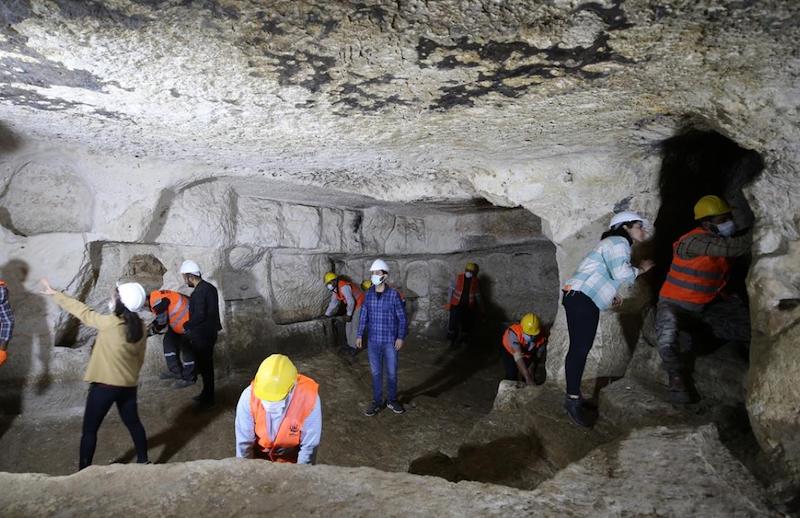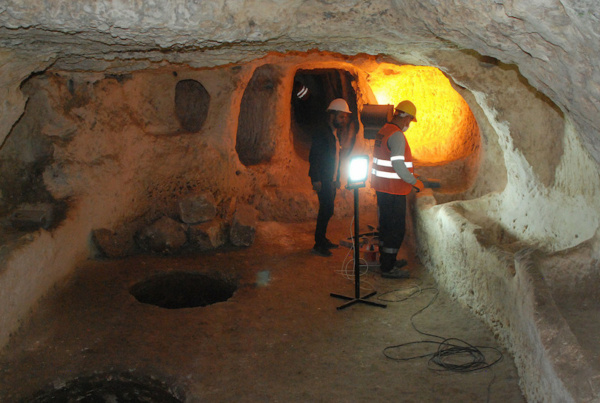
A cave discovered by chance in the south-eastern Turkish town of Midyat, which belongs to the historically rich city of Mardin, led to a sensational discovery about 2 years ago: the cave turned out to be the entrance to a historical cave city of gigantic proportions. Until then, only the Cappadocia region was known for its underground cities, which are also UNESCO World Heritage Sites.
In the cave, which was discovered during cleaning work in the historic streets and houses in the Midyat district, various corridors and a passage to other rooms were found. Excavations were then started to uncover the underground city. The excavations are being carried out by 9 workers, 2 archaeologists, 2 art historians and a restorer.

Many artefacts from the 2nd and 3rd centuries AD have been excavated in the underground city, where there are places of worship, silos, water wells and passages with corridors. Finds show that the underground city was already in use in late Roman times. The city, where excavations continue at two sites in the Ulu Cami district of the district, was named “Matiate” and covers an area that has not yet been finally measured.
Gani Tarkan, director of the Mardin Museum and also head of the excavations in the area, explained that they started the cleaning work at the request of the municipality to understand the quality and continuity of the cave, saying, “We started on a single plot under the house. We have seen that the cave is not a single cave. We saw that the passage to different houses is through tunnels and tunnels from caves under different houses. After that date, we started excavation in two places.” Tarkan further explained , that during the work they started in a cave with three rooms, which until recently was used as a barn or cellar, an entrance was found into a gigantic underground city.

“The first area was a cave with three rooms. From there, a tunnel led north. The length of the tunnel is now 100 metres. We have made a passage to different places through this tunnel. There have been 49 rooms found so far, including a church or synagogue. Some rooms could have been other places of worship. There are also silos and water wells. We see some decorations on the walls. Historical artefacts have also been found: The earliest find so far is from the 2nd and 3rd centuries A.D. This shows us that we are excavating a site from the late Roman period.”
The excavations carried out in two areas will extend to the whole of Midyat, and then similar excavations will be carried out in the surrounding villages of the district. At present, about 3 per cent of it would be made accessible; the underground city is believed to have extended over the entire district. Accordingly, the excavations carried out in two areas will extend to the whole of Midyat, and then similar excavations will be carried out in the surrounding villages of the district. All these places were connected by the corridors.
Areas where the first Christians sought refuge
Similar examples of underground cities can be seen in Anatolia, but the underground city in Midyat has very different characteristics. “The underground city found was in continuous use for at least 1,900 years. It was first built as a hiding place or refuge. As we know, Christianity was not an official religion in the 2nd century. Families and groups who converted to Christianity sought shelter in underground cities or founded underground cities to escape persecution by Rome. Probably the underground city of Midyat was one of the dwellings built for this purpose. It’s not just a shelter, but an area where we estimate that at least 60,000 to 70,000 people lived underground.”

“It is an exciting discovery…. Behind this town lies another history, another time and above it another story. While the houses above are dated to the 17th, 18th and 19th centuries, underneath is a completely different city and this one is 1900 years old. There is no underground city that covers such a large area. The underground city of Midyat will be unique in terms of the area it covers.”
Midyat, which is a kind of open-air museum in terms of history and culture, houses stone houses, inns, mosques, churches and monasteries that are thousands of years old. The mayor of Midyat, Veysi Şahin, said in an interview that excavation work is continuing to uncover the underground city in Midyat, the city of languages and religions.

Leave a Reply